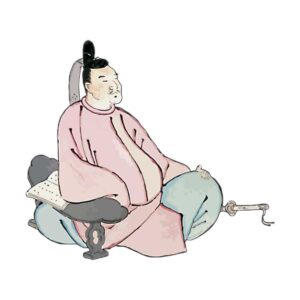
Tea master. Born in 1579.
Born in 1579, his first name was Masakazu. He was a great admirer of both Haruya and Egetsu, and was known as Sobo Taiyu and Korogo-an. He was appointed as a fifth-grade samurai in charge of Enshu, so he is called Enshu or Lord Enshu in honor of Enshu. He was born in Kobori, Sakata-gun, Omi Province (Kobori-machi, Nagahama City, Shiga Prefecture) as the eldest son of Kobori Masatsugu, a vassal of Toyotomi Hidenaga, lord of Yamatokoriyama Castle. 1604 (Keicho 9), at the age of 26, he inherited Matsuyama Castle in Bitchu (Okayama Prefecture), his father’s estate, of 12,000 koku, and was appointed as the governor of En-o in 1619 (Genna 5), when his domain in Bitchu was transferred to Omuro (Asai-cho At the age of 20, he was ordered to be in charge of the construction of Fushimi Castle, Goyozeiin Temple, and Sunpu Castle, and at the age of 20, he was in charge of the construction of the inner palace, the garden of Sento Palace, Nijo Castle, Mizuguchi Tea House in Osaka Castle, Nishinomaru in Edo Castle, Shinagawa Palace, Tokaiji Temple, Nanzenji Temple, and other buildings. He was in charge of the construction of Nijo Castle, the Mizuguchi teahouse at Osaka Castle, Nishinomaru at Edo Castle, the Shinagawa Palace, Tokaiji Temple, Nanzenji Temple, and other temples. In addition, while serving as a magistrate in Fushimi, he was appointed as a political advisor to Yorinobu, Marquis of Kishu, and as an inspector of the Five Kinai Provinces on more than a dozen occasions. In 1645, at the age of 67, he was granted a leave of absence and returned to his Fushimi residence to spend some time with his family. He enjoyed tea ceremonies at Seishu-in, Tengo-an, Shosui-tei, and other places he liked. Enshu learned the tea ceremony from Furuta Oribe, with whom he had a close friendship for 20 years since he was about 18 years old. Enshu’s tea ceremonies were so-called “kirei- sabi,” a combination of the samurai and court noble dynasties’ styles, and he preferred to use not only Waicha, a small tatami room, but also the bright atmosphere of Shoin and Chain Room as a place for socializing and culture of the feudal lords, and many of the utensils were of neat and elegant style. Enshu studied waka poetry from early on under the tutelage of Kinoshita Nagayoko and Reizei Tamemitsu, and his travel writings, such as “Muneho-no-Ko’s Travel Diary,” are still extant. In Zen, Enshu studied under Zen master Haruya Soen and received the title of “Tairu,” or the way of the great master. In calligraphy, Enshu respected the Teika style, and he is considered one of the three most famous calligraphers of the Kan’ei period, along with Konoe Ozan and Shokado Shoujyo. Regarding Enshu and ceramics, his many collections and findings were later called “chukko meimono” in contrast to the great meimono of the Higashiyama period, he chose elegant poem inscriptions from the Kokinshu and other imperial waka anthologies for his tea containers and other inscriptions, he devised a fine bag and hikiya exterior for his vessels, and he used lacquered and decorated boxes. He also added new antique value to tea ceremony utensils, for example, by using a lacquered box with a decorative gold-powder sprinkled calligraphy on it; he had domestic kilns produce his favorites, so-called “Enshu seven kilns”; he sent Gohon to the Busan kiln in Korea to bake new tea ceremony utensils; he ordered kirigata to China, and is estimated to have favored new works, such as underglaze blue and auspicious motifs. He died on February 6, 1647, at the age of 69. He wrote in his resignation, “Kinofu to hifu to shitsureru no mimo no yumenosamu akebono” (The dawn of a dream of a body that has nothing to do). Enshu was the second great master of the tea ceremony after Murata Shuko, Takeno Shaogu, Sen no Rikyu, and Furuta Oribe, especially because of the authority of the shogunate, and the tradition eventually remained as the Enshu style for a long time. His disciples included Shokado Shoujyo, Kuroda Shogen, Yamada Taiyu, Sakuma Naokatsu, and Omori Murata Issai, and his sons were Ozen Masayuki (Sokei) and Gonjuro Masayun (Hozetsu).



